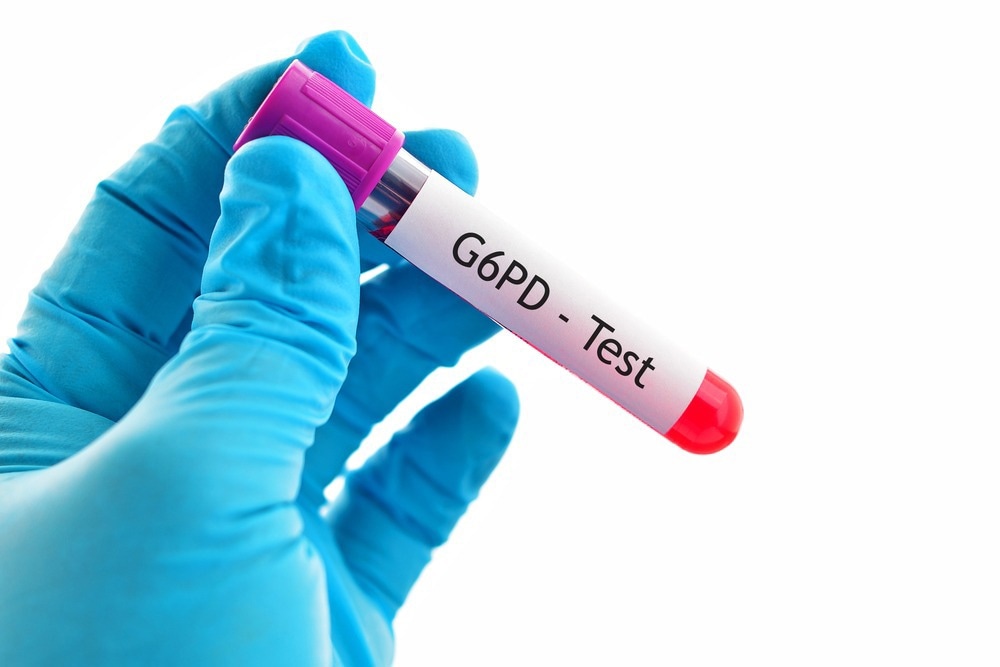Glucose-6-phosphate dehydrogenase (G6PD) deficiency can lead to multiple health disorders and is a serious concern globally. In a paper published in the Microchemical Journal, a ratiometric fluorescence approach for detecting glucose-6-phosphate dehydrogenase was developed using dual-emission carbon dots and silver nanoparticles.

Study: A new ratiometric fluorescent detection of Glucose-6-phosphate dehydrogenase enzyme based on dually emitting carbon dots and silver nanoparticles. Image Credit: Jarun Ontakrai/Shutterstock.com
The Significance of Glucose-6-phosphate Dehydrogenase
The primary physiological function of the glucose-6-phosphate dehydrogenase enzyme is NADPH formation.
NADPH is a vital molecule that acts as a cofactor in various enzymatic activities required for oxidative stress prevention, cell metabolism, and mitochondrial activity.
Genetic mutations in the glucose-6-phosphate dehydrogenase enzyme, which is present in every cell, results in deficiencies of the enzyme.
The deficit is heritable as a result, affecting about 400 million globally. Some patients suffering from this illness may develop acute hemolysis.
Methods for Glucose-6-phosphate Dehydrogenase Detection
The different approaches for the enzyme assay of glucose-6-phosphate dehydrogenase are mainly based on the indirect sensing of NADPH levels.
The simplicity and inexpensive nature of colorimetric and fluorescent approaches make them ideal for enzyme assays.
Unfortunately, enzyme assays using these approaches are insufficiently sensitive, and environmental variables can also influence the outcomes.
Nanoparticles are being used extensively in the development of diagnostic instruments. There are few nanosensors for the enzyme assay of glucose-6-phosphate dehydrogenase.
Colorimetry techniques based on metallic nanoparticles, including gold and silver nanoparticles, have already been developed for these enzyme assays.
Fluorescent Sensing
Fluorescent detectors are widely utilized today for enzyme assays. Many fluorescence sensors rely on switching on or off concepts that are impacted by external factors and can produce false-positive readings.
Fluorescent sensors relying on ratiometric measurements may remove errors caused by the environment or equipment, making the results more accurate.
Chemo/bio-fluorescent sensors highlight the importance of important sensor qualities, including decreased cost, operational simplicity, real-time analysis, and improved detection selectivity and sensitivity.
The Need for Accurate Detection
Inexpensive, quick, and accurate approaches are needed because of the importance of enzyme assays.
Due to inherent background fluorescence and signal variations, the fluorescent chemo/biosensors having a singular fluorescent output cannot identify analytes in enzyme assays reliably.
The ratiometric fluorescence techniques perform the sensing process more accurately and precisely by analyzing the ratio of two different intensity emission wavelengths instead of assessing the intensity of just one wavelength.
The dual ratiometry system uses two signals, allowing self-calibration of signal strengths to prevent the influence of external signals and target-independent components.
Using ratiometric dual-signal output in a chemo/bio fluorescent sensor technique ultimately enhances detection sensitivity and accuracy.
These features highlighted the promise of using the dual-ratiometry system for undertaking accurate enzyme assays of glucose-6-phosphate dehydrogenase.
Research Methodology
In this study, glucose-6-phosphate dehydrogenase was detected utilizing carbon dots (CDs) and silver nanoparticles (AgNPs). Carbon dots were employed because they had a straightforward synthesis process.
The idea was to achieve a noticeable overlapping among the absorption spectrum of silver nanoparticles and the blue diffusion spectrum of dual emission carbon dots (DECDs) distributed in water.
When silver nanoparticles were added to DECDs solution, a considerable overlapping between the absorption spectrum of silver nanoparticles and the blue emission spectrum of DECDs was detected.
By introducing DECDs/AgNPs, blue fluorescence was returned when glucose-6-phosphate dehydrogenase was absent.
Significant Findings of the Study
The team developed a unique fluorescent sensor relying on a ratiometry system using silver nanoparticles and DECDs to detect glucose-6-phosphate dehydrogenase with high sensitivity.
Given the significance of determining in a lab environment whether a patient is heterozygous or homozygous for this enzyme, the proposed approach was able to rapidly determine an adequate range.
The incorporation of silver nanoparticles in the DECDs solution enabled the emission of green and blue fluorescence from DECDs. The internal filter effect occurred because of the decrease in blue fluorescence of DECDs.
When glucose-6-phosphate dehydrogenase was deficient, the enzyme's substrate NADP+ was released into the environment, resulting in agglomeration of silver nanoparticles and red-shifted absorption. This resulted in the recovery of blue emission fluorescence of DECDs.
The DECDs/AgNPs mixture found the glucose-6-phosphate dehydrogenase enzyme in blood samples with higher recoveries and lower relative standard deviation.
This simple and basic fluorescent sensor approach may enable future progress in optical sensing of analytes. Such a development would prove critical for easy, rapid, and effective detection in clinical diagnostics.
Reference
Behzadifar, S., Pebdeni, A. B., Hosseini, M., & Mohammadnejad, J. (2022). A new ratiometric fluorescent detection of Glucose-6-phosphate dehydrogenase enzyme based on dually emitting carbon dots and silver nanoparticles. Microchemical Journal. Available at: https://doi.org/10.1016/j.microc.2022.107947
Disclaimer: The views expressed here are those of the author expressed in their private capacity and do not necessarily represent the views of AZoM.com Limited T/A AZoNetwork the owner and operator of this website. This disclaimer forms part of the Terms and conditions of use of this website.